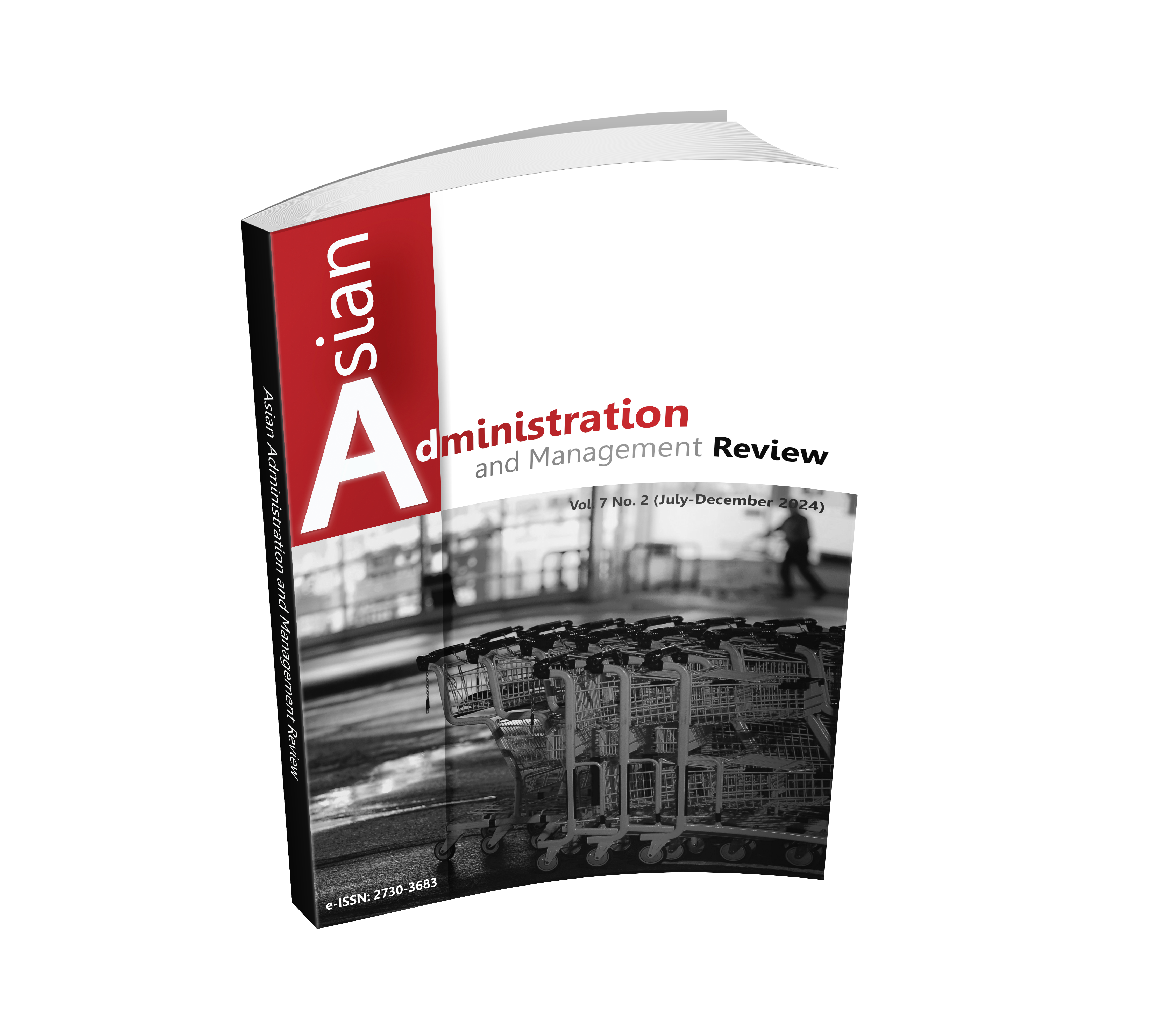CREATIVE ECONOMY, DYNAMIC CAPABILITIES, AND COMPETITIVE ADVANTAGE AFFECTING THE BUSINESS PERFORMANCE OF SMES IN THE TEXTILE MANUFACTURING INDUSTRY OF THAILAND
DOI:
https://doi.org/10.14456/aamr.2024.28Keywords:
Creative Economy, Dynamic Capabilities, Competitive Advantage, Business Performance, SMEsAbstract
This research aimed to analyze the structure and relationships, and to study the path of effects between the creative economy, dynamic capabilities, and competitive advantage affecting the performance of small and medium-sized enterprises (SMEs) in Thailand's textile manufacturing industry. A questionnaire was used for data collection with small and medium enterprise operators in the Thai textile manufacturing industry who are registered as legal entities and are SME members. In this study, confirmatory factor analysis and causal model analysis were used for statistical analysis. The major findings indicated that the analysis of the structural model’s fit to empirical data revealed that the model was consistent with observed data. Considering the magnitude of the direct effect of predictor variables on organizational performance, it was found that the creative economy had a positive direct effect with a coefficient of 0.356 at the .01 level of significance. The capability for innovation directly affected business performance with a positive effect coefficient of 0.526 at the .01 level, and competitive advantage also directly impacted business performance with a positive effect coefficient of 0.612 at the .01 level as well. All predictor variables in the model could explain 78.0% of the variance in business performance and 60.0% of the variance in competitive advantage, respectively.
Downloads
References
Boonsawat, P. (2024). Causal Factors of Competitive Advantages Influencing Performance of Accounting Firms Business. Journal of Management Science Research, Surindra Rajabhat University, 8(1), 149-162.
Bujang, M., & Baharum, N. (2017). A simplified guide to determination of sample size requirements for estimating the value of intraclass correlation coefficient: a review. Archives of Orofacial Science, 12(1), 1-11.
Chankoson, T. (2018). Multilevel Confirmatory Factor Analysis of Green Tourism Management in Thailand for ASEAN Economic Community. Asian Administration and Management Review, 1(2), 88–99.
Christensen, C. (2001). Competitive advantage. Mit Sloan Management Review, 42(2), 105-109.
Chummee, P. (2022). The Adopting a Creative Economy for Competitive Advantages of Community Enterprises. Turkish Journal of Computer and Mathematics Education, 13(1), 236-240.
Chummee, P. (2023). The Structural Equation Model of Creative Economy for Competitive Advantages of Community Enterprises. Journal of Roi Kaensarn Academi, 8(2), 138-151.
Cohen, J. (1977). Statistical power analysis for the behavioral sciences. New York: Academic Press.
Deeds, D., DeCarolis, D., & Coombs, J. (2000). Dynamic capabilities and new product development in high technology ventures: An empirical analysis of new biotechnology firms. Journal of Business Venturing, 15(3), 211-229.
Donkwa, K. (2018). A model of factors in creative economics and innovative behavioraffecting the long-run AEC strategies of Thailand. Silpakon University Journal, 38(1), 207-232.
Eisenhardt, K., & Martin, J. (2000). Dynamic Capabilities: What are They?. Strategic Management Journal, 21(10-11), 1105-1121.
Faul, F., Erdfelder, E., Lang, A., & Buchner, A. (2007). G* Power 3: A flexible statistical power analysis program for the social, behavioral, and biomedical sciences. Behavior Research Methods, 39(2), 175-191.
Griffith, R., Huergo, E., Mairesse, J., & Peters, B. (2006). Innovation and productivity across four European countries. Oxford Review of Economic Policy, 22(4), 483-498.
Halim, M., Ruble, D., & Amodio, D. (2011). From pink frilly dresses to ‘one of the boys’: A social-cognitive analysis of gender identity development and gender bias. Social and Personality Psychology Compass, 5(11), 933-949.
Healy, P., Serafeim, G., Srinivasan, S., & Yu, G. (2014). Market competition, earnings management and persistence in accounting profitability around the world. Review of Accounting Studies, 19(4), 1281-1308.
Henrysson, S. (1963). Correction of item-total correlations in item analysis. Psychometrika, 28(2), 211-218.
Hu, L., & Bentler, P. (1999). Cutoff criteria for fit indexes in covariance structure analysis: Conventional criteria versus new alternatives. Structural Equation Modeling: A Multidisciplinary Journal, 6(1), 1-55.
Hu, W., & Tresirichod, T. (2024). Impact of Green Entrepreneurial Orientation on Sustainable Performance: The Mediating Role of Green Intellectual Capital and Green Supply Chain Management. Asian Administration and Management Review, 7(1), 159-175.
Jiao, H., Wei, J., & Cui, Y. (2010). An empirical study on paths to develop dynamic capabilities: From the perspectives of entrepreneurial orientation and organizational learning. Frontiers of Literary Studies in China, 4(1), 47-72.
Johannessen, J., & Olsen, B. (2003). Knowledge management and sustainable competitive advantages: The impact of dynamic contextual training. International Journal of Information Management, 23(4), 277-289.
Jonpradit, S., Pongyeela, A., & Visalaporn, S. (2014). The Influence of Applying Creative Economy Concept, Factors Driving Creative Economy and Characteristics of Entrepreneurs to Market Success of Five Stars One Tambon One Product (OTOP) in Thailand. Suthiparithat, 28(88), 170-195.
Kačerauskas, T. (2020). Creative economy and the idea of the creative society. Transformations in Business & Economics, 19(1), 43-52.
Kantaratanakul, S., & Jarayabhand, P. (2019). Thailand’s Counter-IUU Fishing Policy: An Analysis of Stakeholder Perceptions. International Journal of Crime, Law and Social Issues, 6(2), 118-129.
Lalaeng, C., & Subongod, M. (2021). The Causal Relationship and Effect of Creative Economy Development: An Empirical Evidence of Community Enterprise. Turkish Journal of Computer and Mathematics Education, 12(14), 626-636.
Li, D., & Liu, J. (2014). Dynamic capabilities, environmental dynamism, and competitive advantage: Evidence from China. Journal of Business Research, 67(1), 2793-2799.
MacCallum, R., Browne, M., & Sugawara, H. (1996). Power Analysis and Determination of Sample Size for Covariance Structure Modeling. Psychological Methods, 1, 130-149.
Mao, L. (2020). Research on the development path of cultural and creative industries in the digital economy era. American Journal of Industrial and Business Management, 10(7), 1237-1249.
McKelvie, A., & Davidsson, P. (2009). From resource base to dynamic capabilities: An investigation of new firms. British Journal of Management, 20(1), S63-S80.
Michailova, S., & Zhan, W. (2015). Dynamic capabilities and innovation in MNC subsidiaries. Journal of World Business, 50(3), 576-583.
Mulyana, M., & Sutapa, S. (2016). The impact of entrepreneurial orientation and collaborative networks on creative industries performance. Jurnal Dinamika Manajemen, 7(2), 166-181.
Navarro, A., Losada, F., Ruzo, E., & Diez, J. (2010). Implications of perceived competitive advantage, adaptation of marketing tactics and export commitment on export performance. Journal of World Business, 45(1), 49-58.
Nunnally, J., & Bernstein, I. (1994). The Assessment of Reliability. Psychometric Theory, 3, 248-292.
Office of National Higher Education Science Research and Innovation Policy Council. (2023). Policy and strategy framework for higher education, science, research and innovation 2023-2027. Retrieved from www.nxpo.or.th/th/ร่าง-กรอบนโยบายและยุทธ/.
Panayides, P. (2007). The impact of organizational learning on relationship orientation, logistics service effectiveness and performance. Industrial Marketing Management, 36(1), 68-80.
Polit, D., & Beck, C. (2006). The content validity index: Are you sure you know what’s being reported? Critique and recommendations. Research in Nursing & Health, 29(5), 489-497.
Protogerou, A., Caloghirou, Y., & Lioukas, S. (2012). Dynamic capabilities and their indirect impact on firm performance. Industrial and Corporate Change, 21(3), 615-647.
Rodrigo-Alarcón, J., García-Villaverde, P., Ruiz-Ortega, M., & Parra-Requena, G. (2018). From Social Capital to Entrepreneurial Orientation: The Mediating Role of dynamic capabilities. European Management Journal, 36(2), 195-209.
Rotjanakorn, A. (2021). The Development of Dynamic Capability for Thai Automotive Industry Performance under the Disruptive of Electric Vehicle Technology. Burapha Journal of Business Management, 10(2), 40-64.
Sakonkharadet, K., Khorchueaklang, S., & Kaew, L. (2017). Structural Relation Model of Dynamic Capabilities, Competitive Advantage and Business Success of Food Processing Industry in Thailand. Journal of Business, Innovation and Sustainability, 12(1), 32-44.
Sriboonlue, U., Chaiprasit, K., & Onputtha, S. (2024). Enhancing Operational Efficiency: Investigating Technology Readiness, Acceptance, and Utilization of Thailand National Single Window in Import, Export, and Logistics Businesses. Asian Administration and Management Review, 7(2), 9-20.
Subongkod, M., & Hongsakul, B. (2024). Structural Equation Modeling for the Business Performance of Private Hospitals in Thailand: Management Perspective. ABAC Journal, 44(3), 24-45.
Teece, D. (2007). Explicating dynamic capabilities: the nature and microfoundations of (sustainable) enterprise performance. Strategic Management Journal, 28(13), 1319-1350.
Teece, D., Peteraf, M., & Leih, S. (2016). Dynamic Capabilities and Organizational Agility: Risk, Uncertainty, and Strategy in the Innovation Economy. California Management Review, 58(4), 13-35.
Thailand Creative Content Agency. (2024). Thailand looks to extend globbal culture reach with launch of Thailand Creative Content Agency. Retrieved from https://thacca.go.th/news/ประเทศไทยตั้งเป้าส่งออกวัฒนธรรมสู่ระดับโลกด้วย-thacca/.
Thailand Development Research Institute. (2023). Thai SMEs and their mission to create economic stability Under the trend of change. Retrieved from https://tdri.or.th/2023/09/economic-sme-article/.
Wanichbancha, K. (2014). Structural equation analysis (SEM) with AMOS. Bangkok: Sam Lada.
Waranantakul, O., & Waranantakul, W. (2022). International Marketing Strategy and Exporting Venture Performance of Exporting Businesses in Thailand. Asian Administration and Management Review, 5(2), 119-130.
Wheaton, B., Muthen, B., Alwin, D., & Summers, G. (1977). Assessing reliability and stability in panel models. Sociological Methodology, 8, 84-136.
Wongwanich, B., & Laohavichien, T. (2023). The influence of dynamic capabilities and innovation on the performance of the electrical and electronics industry in thailand. RMUTT Global Business and Economics Review, 18(2), 57-74.

Downloads
Published
How to Cite
Issue
Section
License
Copyright (c) 2024 Authors

This work is licensed under a Creative Commons Attribution-NonCommercial-NoDerivatives 4.0 International License.











.png)


